How to create outstanding technical documentation - a complete guide 2025

- Who needs technical documentation? Who needs technical documentation?
- Types of technical documentation Types of technical documentation
- How to write effective technical documentation How to write effective technical documentation
- Challenges in creating good technical documentation Challenges in creating good technical documentation
- How structured content can help you How structured content can help you
- AI-enhanced technical documentation AI-enhanced technical documentation
- Are you looking for a technical documentation solution? Are you looking for a technical documentation solution?
In today's fast-paced, tech-driven world, clear communication is more crucial than ever. Whether you're developing software, manufacturing a product, or implementing a new system, technical documentation plays a vital role in ensuring that information is accurately conveyed and understood. In this blog article, we’ll explore what technical documentation is, what are the challenges in creating it and how to overcome them with the right approach and tools.
Technical documentation refers to any document that explains the use, functionality, creation, or architecture of a product or process. It is designed to provide clear and concise information to its intended audience, whether that’s a user, developer, or internal team member. At its core, technical documentation aims to make complex information accessible, helping users achieve their goals with ease.
These documents are usually written by technical writers following strict guidelines and standardized formats like DITA. Technical documentation can range from a simple set of instructions to complex multivolume manuals. It often includes text, images, diagrams, and sometimes video to convey information clearly and comprehensively.
Who needs technical documentation?
Technical documentation is used by any organization that manufactures, sells and supports complex products across various industries like manufacturing, high-tech, financial services, medical devices, pharma, automotive and others. It helps achieve a wide range of purposes, all the way from providing a user manual to a car owner, to supplying maintenance instructions for a field service engineer, to providing supporting documentation for acquiring the market license for a new innovative medical device that will save lives. Let’s look at the different types of technical documentation that various industries are generating.
Types of technical documentation
Technical documentation is presented in myriad formats each with a specific audience, who have specific needs within a specific industry. It goes beyond what people would traditionally consider to be ‘technical’, for example:
- Manufacturing and high-tech
- Digital operation and owner manuals
- Multilingual field service information
- Self-service and support documentation
- Medical devices
- IFUs (instructions for use)
- Technical file for regulatory submissions
- Labels
- Financial services
- Policies and standard operating procedures (SOPs)
- Claims
- Initial public offerings (IPOs) and documents for mergers and acquisitions
From a purpose perspective, we can group technical documentation into the following categories:
- Product documentation: these documents include user manuals, installation guides, and product specifications that help users understand how to use a product effectively.
- Process documentation: SOP workflow documents, and process maps that outline how to perform tasks within a company.
- Policy documentation: documents that define company policies, compliance requirements, and standard procedures.
- Software and hardware documentation: this includes user guides, reference manuals, API documentation and troubleshooting guides for software applications.
For all categories, we can distinguish between internal vs. external documentation. Internal documentation serves the needs of employees, while external documentation is aimed at customers, partners, or the public.
How to write effective technical documentation
When people access technical documentation, they need to fix something, find out something or assess the documentation. In other words, they need to achieve a goal. To reach that goal, they need to perform one or multiple tasks. To be able to perform these tasks, users need technical information that is :
• Easy to use*: write documentation for the intended audience and present information from the reader’s perspective, while making sure that you provide clear, accurate and complete information.
• Easy to understand*: create content that is clear and concise by focusing on the meaning, eliminating wordiness, writing coherently, avoiding ambiguity, using technical terms consistently.
• Easy to find*: place information where people can easily find it by guiding users through the information and by creating a solid content structure.
However, writing technical documentation that is easy to use, understand and find is not an easy task. And the road to achieving this perfect state is sprinkled with a few challenges.
What are the challenges of writing good technical documentation?
As the speed and complexity of content development increases in industries as diverse as life sciences, financial services, manufacturing and more, content teams are finding that their standard applications and processes are no longer up to the job. Inefficiencies and risks that previously were manageable are causing delays and costs and they mainly fall into one of these three categories: collaboration, reuse and governance.
Collaboration challenges
When multiple stakeholders are involved in content development, efficient collaboration is crucial but is often lacking. Many organizations still rely on sequential or parallel workflows, using emails and word-processed files, PDFs or even manually annotated printed documents. This outdated approach leads to a slow and cumbersome process, rife with version-control and consolidation issues – especially when involving external stakeholders like consultants or regulatory bodies. While some have moved to cloud-based word-processing tools that offer concurrent authoring and review, these solutions aren’t enough either. They struggle with scalability and governance, resulting in possible data-loss and frequent content conflicts, especially as the number of contributors or the size of the documents increases.
Additionally, standard word-processing tools lack granular control, limiting the ability to manage access and permissions effectively. Stakeholders may need to be restricted to viewing or reviewing only certain parts of a document, but in a traditional content authoring tool they cannot be assigned only specific sections to edit or review. This lack of precision creates confusion, with contributors unsure of their tasks and often wasting time or providing feedback in the wrong part of the thousand-of-pages long file. Review features in these tools are also limited, with basic comment filtering and no dashboards to track what has been worked on.
Reuse challenges
Content reuse poses significant challenges, especially when it comes to different product variants. As writers create variations of documents for new product models, different geographies, or other needs like training materials, tracking the status of content becomes nearly impossible. Standard word processors lack the capability to indicate which content has already been approved or reviewed leading to inefficiencies. Reviewers often spend unnecessary time re-evaluating the same or identical content, or worse, they overlook critical changes in the source content because the content appears familiar. This not only affects productivity but also compromises the integrity of the review process.
Across an organization, these challenges are magnified as content silos develop within different departments, each recreating content that already exists. This lack of a single source of truth leads to errors, inconsistencies, and missed opportunities for gaining insights into content usage. Additionally, the demand for content across multiple channels – such as online support, augmented reality/virtual reality (AR/VR) training formats, and AI-driven platforms like chatbots – exacerbates these issues. Each time content is duplicated for a new channel, the same inefficiencies resurface, further straining resources and complicating the creation of technical documentation, while increasing the likelihood of incorrect information.
Governance challenges
Governance challenges in creating technical documentation often stem from inadequate audit trails and unreliable change histories. Many organizations struggle to maintain a single, centralized record of feedback and edits during the authoring and reviewing process, which is crucial for audits and regulatory compliance. Even when using cloud-based word-processing platforms, the change history they provide is often insufficient, as they are not designed to offer the level of detail required for audits.
Standard word processors also fall short in helping organizations meet compliance requirements. They offer little guidance on adhering to specific templates or formats, mostly relying on formatting (H1, H2 and similar styles) to indicate the desired structure, but without it being enforced in any way. This leaves room for errors when contributors are unaware of or forget mandated guidelines. Access controls are also inadequate. It is impossible to restrict access to certain parts of a document, forcing an all-or-nothing approach that jeopardizes data security. Moreover, when content needs to be reused, such as adapting documents for new product models, the reliance on ‘save as, copy-pasting, or retyping’ introduces errors and complicates content updates. Identifying and updating every instance of duplicated content is labor-intensive and prone to mistakes, leading to inaccuracies that can compromise compliance and, in critical cases, pose risks to those relying on the content’s accuracy.
Three ways structured content helps your write outstanding technical documentation
So why do so many content teams struggle with large numbers of contributors, content reuse and the ill-governed content? Fundamentally, it’s because they’re using inadequate tools and processes.
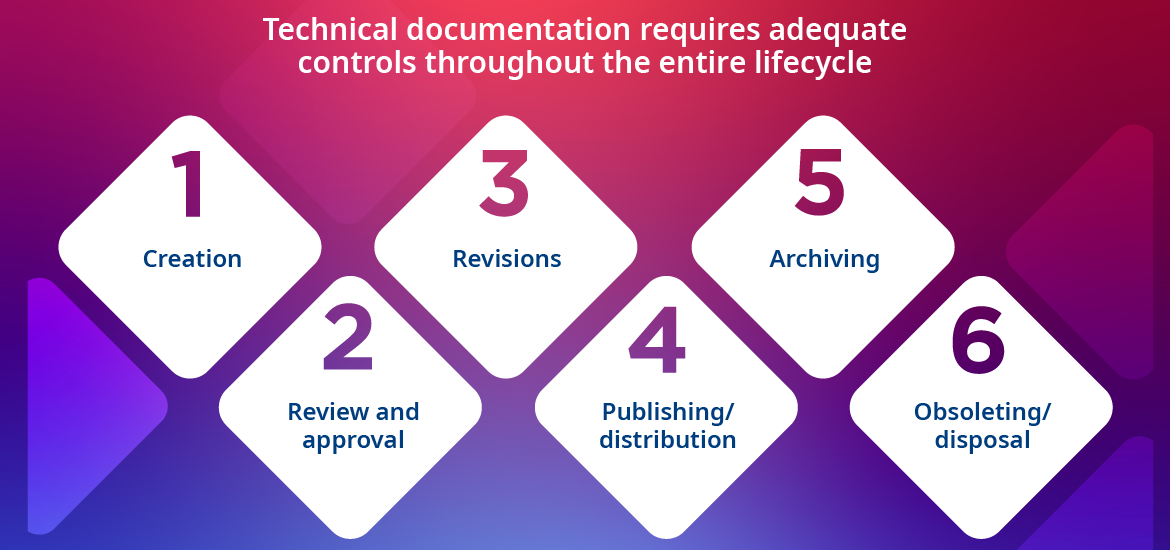
Let’s do a deep dive and see how structured content can help you reduce time and money to create accurate, compliant, consistent and complete technical documentation with concurrent authoring and reviewing, simplified translations processes and good version control.
1. Improved collaboration and content reuse
Agile authoring
Compared to a traditional authoring environment, structured content and CCMS tools enable authors, reviewers and subject matter experts (SMEs) to adopt an agile way of working. As opposed to being created sequentially as a series of pages, individual content components are created independently and in parallel. Once all components have been written, reviewed and approved, they are collated into the final form of the publication. Whenever a change needs to be made, updated versions of the publication can be created far faster, as only the components that require modification need to be updated, and the publication can be easily regenerated.
Each component is written according to a specific definition, which dictates the structure, order and possible elements (text, images, tables etc.) that appear in that content component. The structure is set from the beginning, and it cannot be modified by authors and reviewers – eliminating the possibility of writing content that doesn’t follow the guidelines.
Each content component (sometimes called a module) only needs to be created and approved once. After that, it becomes the single source of truth for its subject matter and purpose. Modules can be widely and immediately reused, reducing duplicated writing effort, and eliminating repetitive creation, editing and approval tasks.
But it doesn’t just make processes faster. That approach also ensures all content is highly consistent, and that the same terms and phrasing are used when talking about the same subject. That consistency improves reader experiences and helps ensure that all documents are clearly understood by the people reading the documentation.
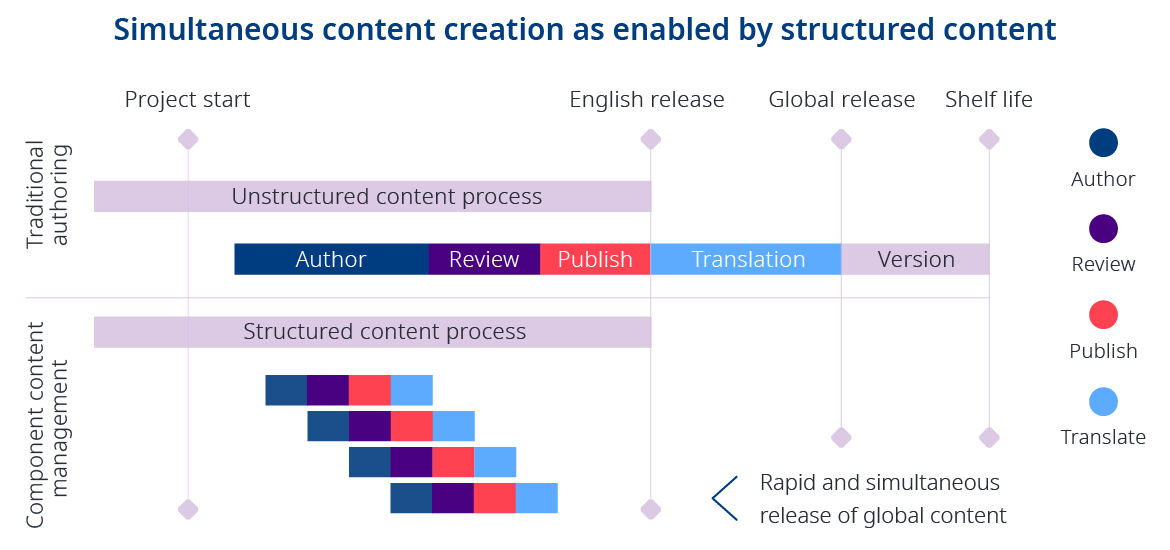
Automated review and approval workflows
With componentized content, technical writers can quickly trace what content chunk has been used where, and how many times, across documents or other output formats. Component authoring also enables accurate change tracking, allowing document owners to see who did what, when and where, and quickly prepare audit trails.
Using a centralized CCMS rather than several different systems to review and approve content, stakeholders will also find it much easier to collaborate and share ideas. All content is stored in the same platform, and is accessible to everyone in the same place, which ensures every stakeholder stays on the same page and works from the same document versions at any given time.
Reviews and comments are held in the same platform too, so editors, reviewers and SMEs don’t have to worry about misplacing or losing them. There is no need for PDFs with annotations or post-its left on printed documents that must be reviewed. All comments and revisions are stored in a single place where the writer can easily manage them by asking further questions, leaving comments, or implementing the suggested changes.
2. Reduced translation times and costs for multilingual content
Translation processes are notoriously complex and time-consuming. But with a structured content platform, translation times can be reduced as much as 60% by empowering teams with:
A single platform for managing all language versions: structured content enables all language versions of components to be stored in the same CCMS which makes it easy to manage and update them. When a component needs to be updated, it’s easy to send it for translation and then integrate it back, creating the new localized documentation version.
Precise component-based translation: instead of localizing entire documents, translators can manage granular pieces of content, substantially reducing translation costs. This approach also reduces delivery time for the translation teams, as it helps them pinpoint exactly what needs to be translated instantly.
Easy integration with translation management tools: working with structured content makes it easy for an organization to start working with translation management and translation memories (TM). This means that once a content component has been translated, the translated version is saved in the TM, reducing time needed for future translations.
Only the remaining parts, those that haven’t been translated before, need to then be translated and incorporated into the TM tool. Modern digital tools allow the integration of machine translation (MT) capabilities in the translation process. This accelerates the process even further by using AI to translate the required passages before being passed to humans for validation.
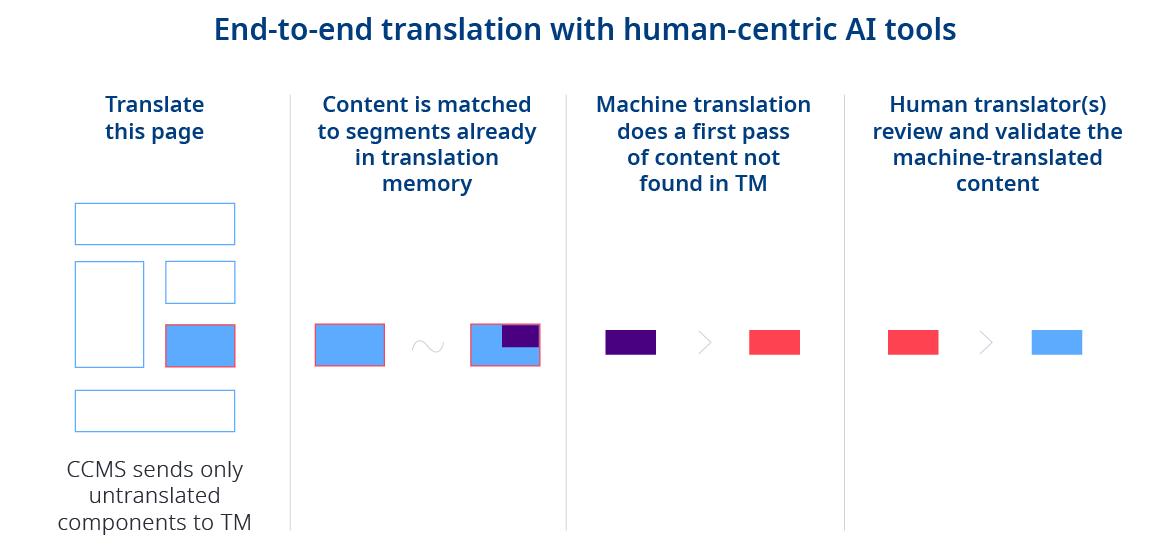
3. Faster document generation and maintenance with strong version control
Structured content significantly accelerates document creation by using components to build and manage content. Once document owners define what they want to cover within their documentation and what version of the content, they can quickly and easily pull in pre-approved content modules to bring their new documents to life and publish them at speed.
With a CCMS, the same content components can be integrated into consumer-facing assets, like product documentation, websites, but also in-device documentation such as in electrical vehicles (EV). But the same content can be used to enable internal staff, partners or field service engineers to name a few. Teams can create and manage multiple document versions at the same time, ensuring documents in all languages are up to date and complete – while maintaining a clear version log and audit trail for traceability.
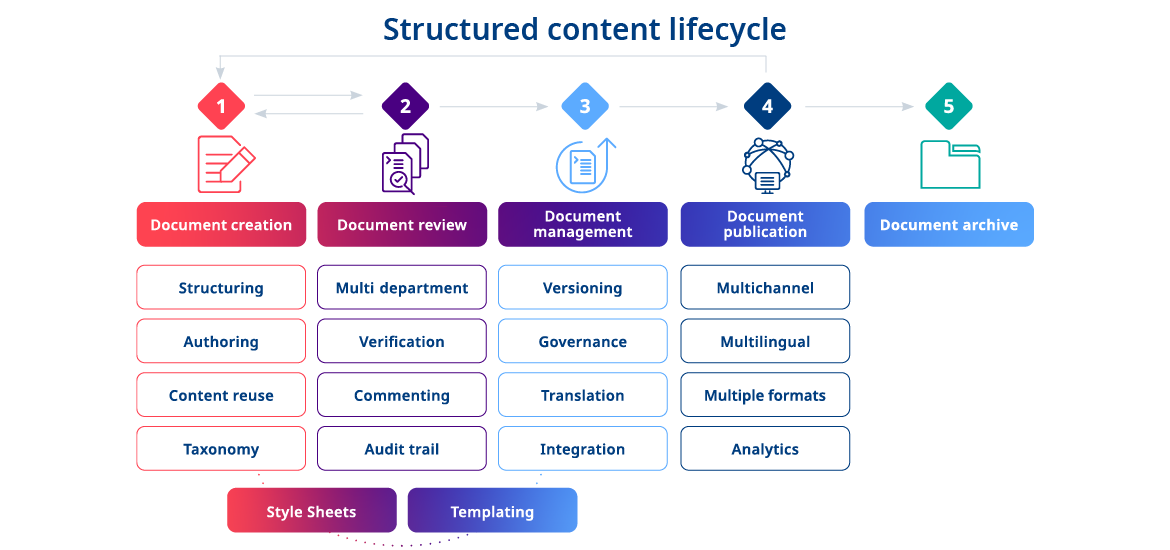
Next level: AI-enhanced technical documentation
We have discussed in the beginning the main traits of good technical documentation: easy to use, easy to understand and easy to find. In the previous section we proved how structured content, through its intrinsic properties together with automated processes considerably boost documentation creation, review, management and publishing as to make information more palatable to the everyday user or to external regulatory agents. But we haven’t really talked about how structured content can make your information easy to find and process by AI.
Metadata and taxonomies
A crucial piece of the content and data management puzzle is ensuring that information is easy to find for all the stakeholders that need to access it. This can be achieved by implementing componentized content that is metadata-tagged, ideally using industry taxonomies. This way, content is semantically enriched while building connections between content components. Content has a distinct meaning and purpose identified by metatags and is much easier to find by technical writers, in a CCMS or by content consumers and by AI tools. Information findability can increase even further with the help of machine learning algorithms.
"Documents that are enriched with structured data will become more mainstream to help with high-volume transactional document processing"
Cheryl Mckinnon, principal Analyst, Forrester
Semantic AI
Semantic AI algorithms can be added to a CCMS to scan content and understand what it means. Coupled with the relationship between different content elements provided by taxonomies and metatags, you now have a structured content management tool where technical writers can identify content faster, structure and organize it in a consistent way and reuse it wherever needed.
Generative AI
Generative AI (Gen-AI) is taking that efficiency and accelerates things even further. While we are still quite a long way from generative AI tools being able to handle complex technical documentation tasks on their own, capabilities have emerged that can give writers a lot of support.
There’s no doubt that Gen-AI will change content creation for technical writers – but not quite in the way some fear. Gen-AI AI algorithms can help them by tasks such as:
- Suggesting rephrased versions of sentences or paragraphs with a poor readability score
- Detecting incorrect usage of terms or product names and proposing alternatives
- Acting as a virtual assistant for writers and helping them find information faster
In parallel, there is another important application of Gen-AI gaining fast traction as well: information retrieval. With a Gen AI-enhanced knowledge portal people can find information faster be it on a public customer portal or on internal knowledge repositories. With the help of chat windows people can now ask their question and receive the answers they were looking for together with the source where the information is coming from – a detail that is crucial to obtaining and using verifiable, precise and contextual information.
To receive this high-quality information there is a special technique being used: it is called RAG – Retrieval Augmented Generation. In shorter and simpler terms, when a person is asking a chatbot a question, the chatbot will first perform a search in the documentation to narrow down the complete collection of information. It can use metadata that describes the content to help with creating the right subset, e.g. based on tags identifying product, model, version, target market, audience or other criteria that the content relates to. Based on that subset of information the large language model (LLM) extracts the relevant information and constructs the response, phrasing it in a way that is easy to understand for the person who asked the question.
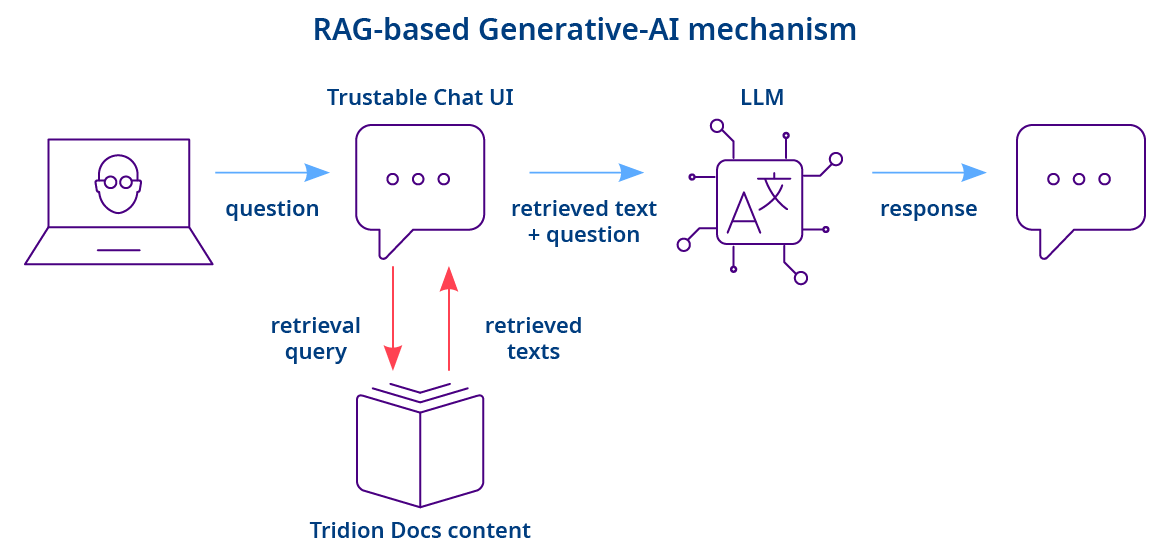
While Gen-AI is not yet a common part of everyday life for most people, it is being adopted at a rapid pace and will soon be integrated into much of our technology, often without us even noticing. Companies that use structured content for their technical documentation are positioned well ahead of others, offering significant benefits to both human users and AI systems.
Are you looking for a technical documentation solution?
Discover Tridion® Docs today to see how we can help optimize your documentation processes and give you an advantage with AI-assisted content creation and delivery.
